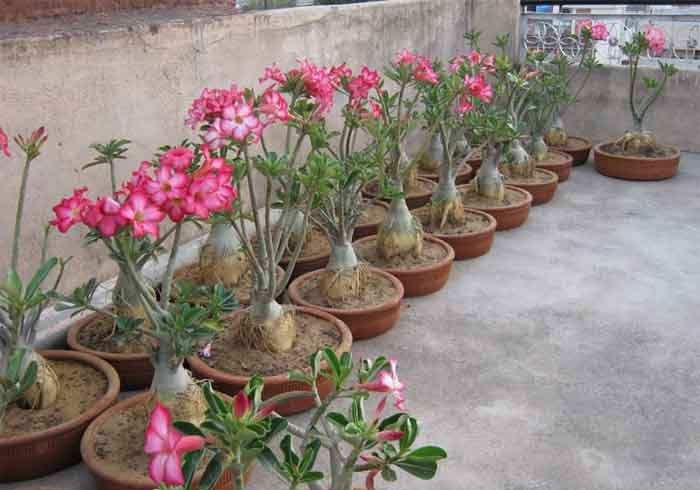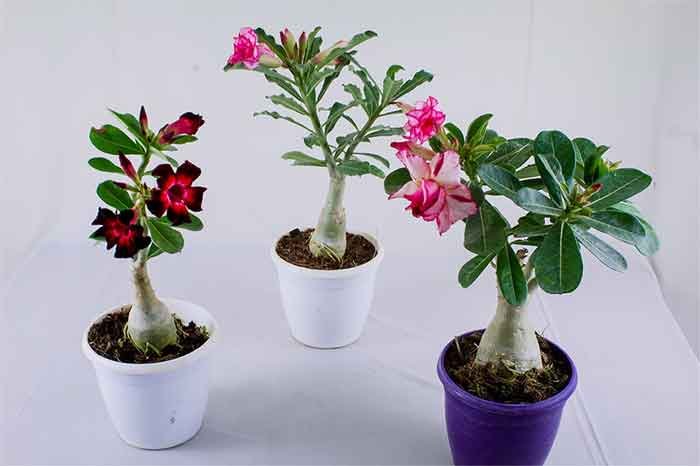The Adenium Plant is a beautiful and unique plant that has many different features which make it an interesting addition to any home or garden.
It is native to the deserts of Africa and Arabia and has been used for centuries by the local people for its medicinal properties.
The plant is also known as the Desert rose, and is a member of the Hibiscus family. The Adenium Plant has a long history and was first introduced to Europe in the late 18th century.
It is easy to care for and can thrive in a wide range of conditions. With its interesting features and long history, the Adenium Plant is a perfect addition to any home or garden.
Overview of Adenium Plant
They are commonly known as desert roses or simply adeniums. Adeniums occur in dry tropical regions throughout Africa, Arabia, and Madagascar, with Adenium obesum extending into southern Asia as far as Sri Lanka.
Also read about brahmi plant and its care here.
The scientific name “Adenium” derives from the ancient Latin name for these plants, adenoma, meaning “swelling”. This refers to the caudices (trunks) of some species which can become swollen with stored water, allowing them to survive long periods without rainfall. The common English name “desert rose” arises from the fact that these plants grow in arid regions, where they receive little rainfall.
The genus Adenium belongs to the dogbane family (Apocynaceae), which also includes oleanders (Nerium) and periwinkles (Vinca). The flowers of most adeniums are large and showy, with colors ranging from white through pink to red.
The flowers have five petals arranged in a spiral pattern, with the outermost petals being larger than those closer to the center. The stamens are arranged in a ring around the pistil, with fused anthers forming a tube through which pollen is emitted. Adeniums can be either deciduous or evergreen, depending on the species.
The leaves of adeniums are simple and opposite, with entire margins. They are often fleshy and glossy and may be green, red, or variegated. The stems are thick and fleshy, often swollen at the base where they store water. Adeniums typically have a taproot, which is important in allowing the plant to access deep groundwater during periods of drought.
Many species of adenium are grown as ornamental plants for their flowers and interesting stem shapes. They are popular houseplants in many parts of the world and are also used in bonsai.
Consider reading and viewing jute plant images here and how to grow them.
Some varieties have been developed for use as grafting stock for other members of the family Apocynaceae, such as Plumeria (frangipani). A few species, such as Adenium obesum, are toxic to humans and animals if ingested.
How to Grow Adenium Plant?
To grow an adenium plant, you will need:
- A pot or container with drainage holes
- Adenium obesum seedlings or cuttings
- Potting mix
- A sunny spot
- Water
Follow these steps to grow your adenium plant:
Have a look at bamboo plant benefits here.
- Fill the pot or container with a well-draining potting mix.
- Plant the adenium obesum seedling or cutting in the pot or container, making sure that the roots are buried and the stem is pointing up.
- Place the pot or container in a sunny spot.
- Adenium obesum plants are drought-tolerant and can go long periods without water, but they will flower and grow more vigorously with consistent moisture.
With proper care, your adenium plant will thrive and bloom with beautiful flowers. Enjoy growing this unique and interesting plant!
Read a bit about the dieffenbachia seguine plant here.
How to take care of Adenium Plant?
Watch for pests and diseases and remove any dead or dying leaves or stems. With proper care, your Adenium Plant will thrive.
Besides this, here are a few more tips that can help you take care of your Adenium Plant:
- Adeniums prefer bright, indirect sunlight.
- When watering, water thoroughly so that water runs through the drainage holes in the pot.
- Fertilize monthly with a well-balanced fertilizer.
- If you live in an area with cold winters, bring your Adenium indoors or protect it from frost by covering it with a frost cloth or burlap.
- Watch for pests and diseases such as aphids, mealybugs, and root rot.
- Remove any dead or dying leaves or stems as soon as you see them.
- Also read about touch me not plant scientific name here and more about it.
How to propagate Adenium Plant?
Adeniums can be propagated from seeds or cuttings.
- Keep the soil moist but not soggy. When the seedlings are large enough to handle, transplant them into individual pots.
- To propagate from cuttings, take a 6-8 inch (15-20 cm) cutting from a stem that has some leaves.
- Remove the lower leaves so that only 2-3 remain on the cutting. When the cutting has rooted, transplant it into an individual pot.
- Also read how to propagate swiss cheese plant here.
Benefits of Aden
- They are drought tolerant and can withstand periods of extended dryness.
- Adeniums are relatively pest and disease-free.
- These plants produce beautiful flowers in a wide variety of colors.
- Adeniums make excellent houseplants and can be grown indoors with proper care.
- Here is jade plant benefits for your reference.
Problems with Adenium Plants
- Overwatering: Adeniums are native to arid and semi-arid climates, so they don’t need a lot of water. If your plant is wilting, it’s probably because it’s getting too much water.
- Too much fertilizer: Adeniums don’t need a lot of fertilizer, and too much can be harmful. If you think your plant might be over-fertilized, flush the soil with water to dilute the fertilizer and then cut back on future feedings.
- Disease: Adeniums can be susceptible to fungal diseases such as root rot and powdery mildew. If you think your plant might be diseased, consult a professional for diagnosis and treatment options.
For spider plant benefits refer to this.
Tips to Decorate House with Adenium Plant
If you want to add a touch of natural beauty to your home, consider decorating with an Adenium plant. Also known as the desert rose, these plants are native to Africa and Arabia and thrive in hot, dry climates. Adeniums come in a variety of colors, including pink, red, white, and yellow, and their showy flowers make them a popular choice for indoor or outdoor decoration.
Here are some tips for decorating with Adenium plants:
- Place them in a sunny spot. If you live in a cold climate, you can grow Adeniums indoors near a south-facing window.
- Give them room to grow. Adeniums can grow up to 3 feet tall and wide, so make sure to give them plenty of space. If you’re potting them, choose a container that’s at least 12 inches in diameter.
Consider Reading:
Conclusion
Adeniums are easy-to-grow plants that make beautiful additions to any home. With their showy flowers and glossy leaves, these plants can brighten up any space. Just be sure to give them plenty of sun and room to grow, and you’ll have a thriving Adenium plant in no time.


